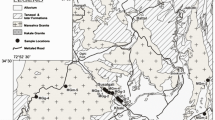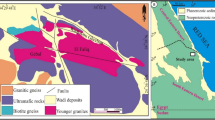Abstract
Different kinds of igneous rocks can be used as building stones due to their durability, appearance, and availability. Because of their hardness and durability, granitic rocks have been used as building stones. In this research, 48 rock samples of granitic rocks collected from two sites in the study area in Najran were evaluated based on the geological, petro-physical, and geo-mechanical properties. Mineralogically, granite consists mainly of coarse-grained quartz, potassium feldspar, sodium feldspar, and hematite, as well as the secondary minerals such as mica (muscovite and biotite) and hornblende. The primary wave velocity (Vp) measurements of rocks in dry conditions showed average of 4.65 and 4.55 km/s for black granite (BG) and grey granite (GG), respectively. The uniaxial compressive strength (UCS) of the tested specimens under dry conditions was generally high, averaging 173 and 137 MPa for BG and GG, respectively. Correspondingly, the impact strength index (ISI) had an average of 79%. The measured Brazilian strength value had an average of 17.84 and 14.15 MPa for BG and GG, respectively. Finally, in BG and GG, the Böhme test had minimum values of 2.25, 8.68 cm3/50 cm2, maximum values being 10.2, 13.43 cm3/50 cm2, and average values being 6.80, 10.33 cm3/50 cm2, respectively. The results were used to calculate the weights and estimates of the physical-mechanical aspects as well as the quality index (QI) for the studied specimens. The QI values are 70 for BG and 58 for GG rocks in the Najran region which are rated very good. These QI values indicate that they are ideal for building and floor covering purposes. The present study concludes that Najran granite can be used for all purposes related to interior cladding and exterior wall-facing stones.










Similar content being viewed by others
References
Abd El Aal A, Nabawy BS (2017) Implications of increasing the ferruginous cement on the physical and mechanical properties of the Cambro-Ordovician Wajid Sandstone in southwest Saudi Arabia: applications for construction purposes. Bull Eng Geol Environ 78(2):817–836
Abd El-Aal AK, Salah MK, Khalifa MA (2020) Acoustic and strength characterization of Upper Cretaceous dolostones from the Bahariya Oasis, Western Desert, Egypt: The impact of porosity and diagenesis. J Pet Sci Eng 187(2020):106798. https://doi.org/10.1016/j.petrol.2019.106798
Al-Eshaikh MA, Kadachi A (2006) Toxic heavy metal analysis in residential paint using X-ray fluorescence (XRF) technique. In: Proceedings of the 12th International Conference on Machine Design and Protection, September 5–8, 2006, Kuşadası, Turkey (CD-ROM).
Ali MAM, Yang H (2014) A study of some Egyptian carbonate rocks for the building construction industry. Int J Min Sci Technol 24:467–470
Ali MAM, Abdellah WR, El Aal AA (2020) The Influence of the Physical and Mechanical Properties on the Abrasion Rate of Rocks Along Idfo-Marsa Alam, Eastern Desert, Egypt. Geotech Geol Eng 38(2020):1567–1577. https://doi.org/10.1007/s10706-019-01112-8
Anon OH (1979) Classification of rocks and soils for engineering geological mapping: part 1—rock and soil materials Bulletin of Engineering Geology and the Environment, 19 (1) (1979), pp. 364-371
ASTM (1978) Standard method for laboratory determination of pulse velocities and ultrasonic elastic constants of rocks. Annual Book of ASTM Standards, Part 19. D. 2845-69:356–363
ASTM D638-14, Standard Test Method for Tensile Properties of Plastics, ASTM International, West Conshohocken, PA, 2014, www.astm.org
ASTM D3967-95a: Standard Test Method for Splitting Tensile Strength of Intact Rock Core Specimens. 10.1520/D3967-95A
ASTM D2938-95(2002), Standard Test Method for Unconfined Compressive Strength of Intact Rock Core Specimens (Withdrawn 2005), ASTM International, West Conshohocken, PA, 1995, www.astm.org. https://doi.org/10.1520/D2938-95R02
Basu A, Ghosh N, Das M (2012) Categorizing weathering grades of quartzitic materials and assessing Brazilian tensile strength with reference to assigned grades. Int J Rock Mech Min Sci 49:148–155
Bell FG (1987) Engineering properties of soils and rocks. Butterworths, London
Bilgin N, Seyrek T, Shahriar K (1988) Roadheader performance in Istanbul, Golden Horn clean-up contributes valuable data. Tunnels and Tunnelling (June), 41–44.
Evans I, and Pomeroy, CD (1966) The Strength, Fracture and Workability of Coal. Pergamon Press, London.
Hecht CA, Bonsch C, Bauch E (2005) Relations of rock structure and composition to petrophysical and geomechanical rock properties: examples from Permocarboniferous Red-Beds. Rock Mech Rock Eng 38(3):197–216
Ida H, Segawa T, Tohyama S, Kawai J (2005) Analysis of Painted Steel by Hand-held X-ray Fluorescence Spectrometer. Kyoto University, Skyo-Ku, 606-8501 Japan.
ISRM (2007) In: Ulusay, R., Hudson, J.A. (Eds.), The Complete ISRM Suggested Methods for Rock Characterization Testing and Monitoring, p. 628.
ASTM C20-00(2015), Standard Test Methods for Apparent Porosity, Water Absorption, Apparent Specific Gravity, and Bulk Density of Burned Refractory Brick and Shapes by Boiling Water, ASTM International, West Conshohocken, PA, 2015, www.astm.org. https://doi.org/10.1520/C0020-00R15
ISO14689-1 (2003) Geotechnical investigation and Testing-Identification and classification of Rock-Part 1: identification and description.
Jamshidi A, Nikudel MR, Khamechiyan M, Sahamieh RZ, Abdi Y (2016) A correlation between P-wave velocity and Schmidt hardness with mechanical properties of travertine building stones. Arab J Geosci 9:568
Kahraman S, Soylemez M, Fene M (2008) Determination of fracture depth of rock blocks from P-wave velocity. Bull Eng Geol Environ 67(1):11–16
Karaman K, Kesimal A (2014) A comparative study of Schmidt hammer test methods for estimating the uniaxial compressive strength of rocks. Bull Eng Geol Environ 74:507–520. https://doi.org/10.1007/s10064-014-0617-5
Kuscu M, Yıldız A, Bagcı M (2003) Investigation of Ağın andesite as a building stone (Iscehisar-Afyon, W-Turkey). International symposium on industrial minerals and building stones, Istanbul, Turkey, pp 243–253
Moos AV, De Quervain F (1948) Technische Gesteinkunde. Verlag Birkhauser, Basel
Mostaf T, Ali MAM, El-Beblwi MA, Mohamed AY, Hassan A (2009) Quality index as a mean to determine the optimum utility of limestone for different purposes. In: 11th international conference on mining, petroleum and metallurgical engineering. Mining and Metallurgical Department, Faculty of Engineering, Suez University, Sharm El-Sheikh, 15–19 March 2009, pp 555–565
Quick GW (2002) CSIRO Building. Selective guide to the selection of dimension stone, Construction and Engineering, Highett, Victoria, Australia 3190: 01–03
Sable EG (1985) Explanation notes on the geologic map of the Najran quadrangle Sheet 17G. Arabi, Kingdom of Saudi
Salah MK, Abd El-Aal AK, Abdel-Hamee AT (2019) Influence of dеpositional and diagеnеtic procеssеs on the pеtrophysical and mеchanical propеrtiеs of Lowеr Miocеnе sandstonеs, Qattara Dеprеssion, Northwеstеrn Еgypt. J Pet Sci Eng 177:1114–1133. https://doi.org/10.1016/j.petrol.2019.02.058
Salah MK, Alqudah M, Abd El-Aal AK, Barnes C (2018) Effects of porosity and composition on seismic wave velocities and elastic moduli of lower Cretaceous rocks, central Lebanon. Acta Geophys 66:867–894. https://doi.org/10.1007/s11600-018-0187-1
Sharma PK, Khandelwal M, Singh TN (2011) A correlation between Schmidt hammer rebound numbers with impact strength index, slake durability index and P-wave velocity. Int J Earth Sci (Geol Rundsch) 100:189–195
Sharma PK, Singh TN (2008) A correlation between P-wave velocity, impact strength index, slake durability index and uniaxial compressive strength. Bull Eng Geol Environ 67:17–22
Siegesmund S, Dürrast H (2014) Physical and mechanical properties of rocks. In: Siegesmund S, Snethlage R (eds) Stone and architecture. Springer, Berlin. https://doi.org/10.1007/978-3-642-45155-3_3
Sims I (1991) Quality and durability of stone for construction. Q. J. Eng. Geol. 24, 67-73.-73.
Singh TN, Kanchan R, Saigal K, Vеrma AK (2004) Prediction of P-wavе velocity and anisotropic property of rock using artificial nеural nеtwork tеchniquе. J Sci Indust Rеs 63(1):32–38
Sousa O (2014) Petrophysical properties and durability of granites employed as building stone: a comprehensive evaluation. Bull Eng Geol Environ 73:569–588
Teme SC (1991) An evaluation of the engineering properties of some Nigerian limestones as construction materials for highway pavements. Eng Geol 31:315–326
Teme SC Edet AE (1986) Strength characteristics of some Nigerian limestone implications for the construction industry. In: Proceedings of the regional seminar in earth sciences, first ANSTIUNESCO earth sciences subnetwork, Dakar, pp 8–17.
Acknowledgements
The authors would like to express their gratitude to the Ministry of Education and the Deanship of Scientific Research at Najran University, Kingdom of Saudi Arabia, for their financial and technical support under code number NU/ESCI/17/014. The authors would also like to acknowledge Bin Harkil Co. Ltd. for granite for their logistic support during the research. Moreover, the authors are indebted to the editor in chief of Arabian Journal of Geosciences and the anonymous reviewers for their worthy time and comments that reconstructed and improved the quality of the study.
Author information
Authors and Affiliations
Corresponding author
Ethics declarations
Conflict of interest
The authors declare no competing interests.
Additional information
Responsible Editor: Zeynal Abiddin Erguler
Rights and permissions
About this article
Cite this article
Alsaiari, M.A., El Aal, A.A. Influence of composition on the physico-mechanical properties of granitic rocks used in floor covering and building cladding in Najran Region, Saudi Arabia. Arab J Geosci 14, 2100 (2021). https://doi.org/10.1007/s12517-021-08387-3
Received:
Accepted:
Published:
DOI: https://doi.org/10.1007/s12517-021-08387-3




